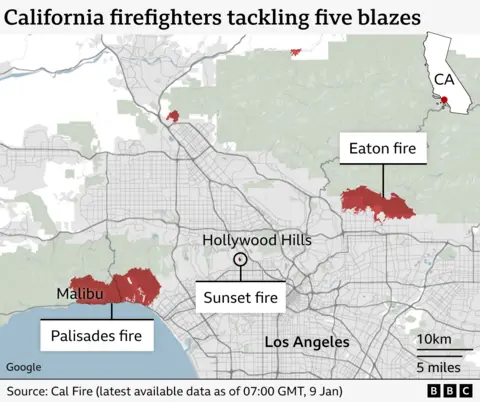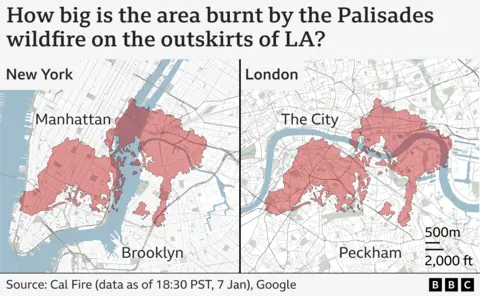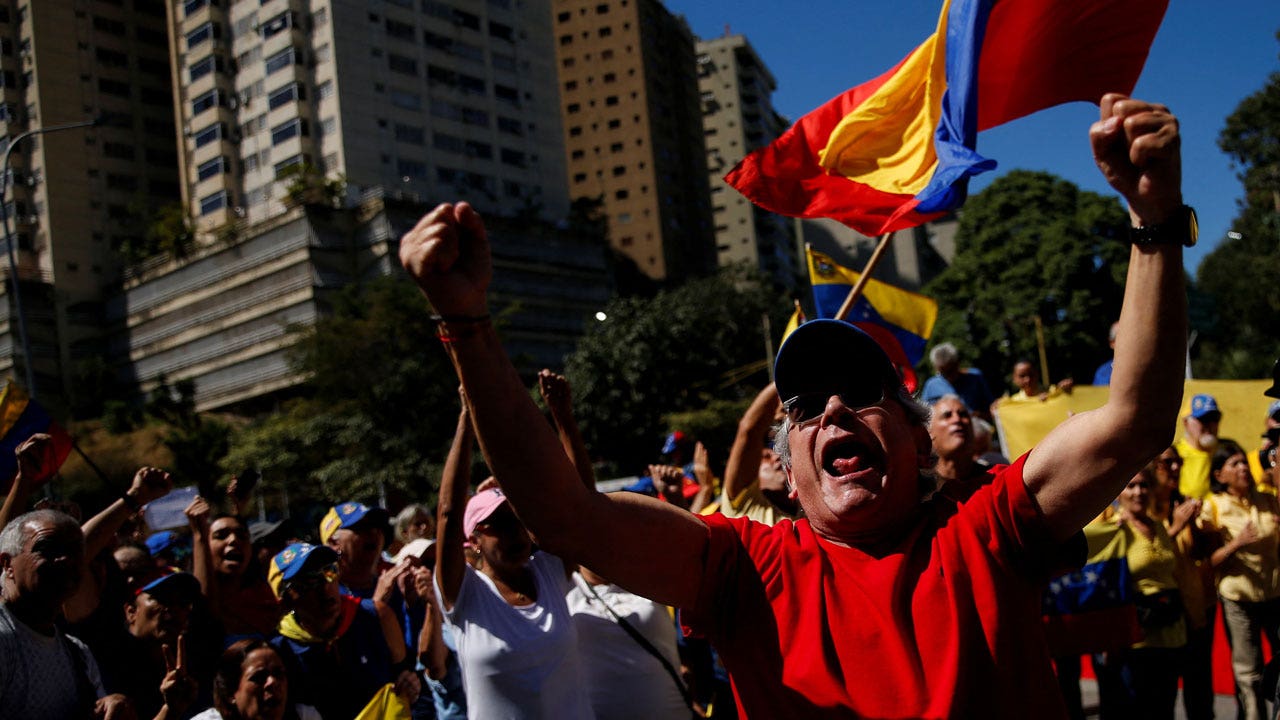News
LA fires: What's happening in Los Angeles, and what caused the wildfires?

Out-of-control wildfires are ripping across parts of Los Angeles, leading to at least five deaths, burning down hundreds of buildings, and prompting more than 130,000 people to flee their homes in America’s second-largest city.
Despite the efforts of firefighters, the biggest blazes remain totally uncontained – with weather conditions and the underlying impact of climate change expected to continue fanning the flames for days to come.
What’s the latest?
More than 137,000 people have been forced to leave their homes – many of them simply carrying whatever belongings they can.
Police say at least five people have died, and their bodies found near the Eaton Fire – but their cause of death is not yet known.
Like the even larger Palisades Fire, the Eaton Fire remains totally uncontained. Meanwhile, the new Sunset Fire is menacing the well-known Hollywood Hills area.
More than 1,000 structures are known to have been destroyed – including houses, schools and businesses on the iconic Sunset Boulevard. A fire ecologist has told the BBC that “entire neighbourhoods… have been wiped out”.
Among the celebrities who have lost their homes are Leighton Meester and Adam Brody, who attended the Golden Globes just days ago, and Paris Hilton.
There is a glimmer of hope for firefighters, as the fire weather outlook for southern California has been downgraded from “extremely critical” to “critical”.
But BBC weather forecaster Sarah Keith-Lucas says there is no rain forecast in the area for at least the next week, meaning conditions remain ripe for fire.
Mass disruption has been reported due to traffic buildup. A number of schools and the the University of California, Los Angeles (UCLA) have been forced to close.
A political row about the city’s preparedness has erupted after it emerged that some firefighters’ hoses have run dry – an issue seized upon by US President-elect Donald Trump.
Where are the fires?

There are at least five fires raging in the wider area, according to California fire officials early on Thursday:
- Palisades: The first fire to erupt on Tuesday and the biggest fire in the region, which could become the most destructive fire in state history. It has scorched a sizable part of land, covering more than 17,200 acres, including the upscale Pacific Palisades neighbourhood
- Eaton: It has struck the northern part of Los Angeles, blazing through cities such as Altadena. It’s the second biggest fire in the area, burning around 10,600 acres
- Hurst: Located just north of San Fernando, it began burning on Tuesday night and has grown to 855 acres, though firefighters have had some successlimited in containing it
- Lidia: It broke out on Wednesday afternoon in the mountainous Acton area north of Los Angeles and grew to cover almost 350 acres. Authorities say it has been 40% contained
- Sunset: It broke out Wednesday evening in Hollywood Hills, growing to about 20 acres in less than an hour. It now covers around 43 acres
The earlier Woodley and Olivas fires have now been contained, according to local fire authorities.
How did the LA fires start?
Officials have pointed to high winds and drought in the area, which has made vegetation very dry and easy to burn.
The likely impact of climate change has also been cited been blamed – although the exact circumstances remain unclear.
Some 95% of wildfires in the area are started by humans, according to David Acuna, a battalion chief at the Californian Fire Service, although officials are yet to state how they think the current fires started.
An important factor that has been cited in the spread of the blazes is the Santa Ana winds, which blow from inland towards the coast. With speeds of more than 60mph (97 km/h), these are believed to have fanned the flames.
What role has climate change played?
Although strong winds and lack of rain are driving the blazes, experts say climate change is altering the background conditions and increasing the likelihood of such fires.
US government research is unequivocal in linking climate change to larger and more severe wildfires in the western United States.
“Climate change, including increased heat, extended drought, and a thirsty atmosphere, has been a key driver in increasing the risk and extent of wildfires in the western United States,” the National Oceanic and Atmospheric Administration says.
And following a very warm summer and lack of rain in recent months, California is particularly vulnerable.
Fire season in southern California is generally thought to stretch from May to October – but the state’s governor, Gavin Newsom, has pointed out earlier that blazes had become a perennial issue. “There’s no fire season,” he said. “It’s fire year.”
Speaking to the BBC, Mr Acuna said the Palisades Fire represented only the third occasion in the past 30 years that a major fire had broken out in January.


News
Live news: Los Angeles sheriff confirms wildfire looting arrests

Los Angeles firefighters have managed to contain three smaller wildfires, though the largest fires remain uncontained as the southern California region continues to navigate one of its most destructive natural disasters.
The Woodley, Sunset and Sunswept fires have all been contained as of Thursday morning, authorities said.
The Palisades fire has spread 17,200 acres as of Thursday morning. Los Angeles Fire Department chief Kristin Crowley said wind gusts were up to 60mph and expected to resume throughout the day. She estimated that thousands of structures had been damaged.
Los Angeles County Fire chief Anthony Marrone said growth of the Eaton fire had been “significantly stopped”, but the fire — which has spread to 10,600 acres — had not been contained and more than 1,000 structures had been damaged.
The third largest wildfire, Hurst, has spread 855 aces and has also not yet been contained.
Read more here
News
Photos: See the California wildfires' destructive force, in satellite images

This is a developing story. For the latest local updates head to LAist.com and sign up for breaking news alerts.
Fast-moving fires are blazing trails of destruction in the Los Angeles area, killing at least five people, injuring many more, and destroying hundreds of homes and businesses. Satellite images by Maxar Technologies show homes and businesses before the fires started and the charred aftermath after one day.
The Palisades fire has burned more than 17,000 acres, including homes along the Pacific Coast Highway. The fire has also damaged landmarks across Los Angeles County, including some vegetation and trees on the site of the Getty Villa, a Greco-Roman art museum on the highway.
In the image from Jan. 8, the remains of homes in Altadena, Calif., near Marathon Road are seen from space after the Eaton fire blazed through the area. The Eaton fire has destroyed 10,600 acres, including parts of Altadena, north of Pasadena, an area bordering the Angeles National Forest.
Homes and businesses along Altadena Drive are seen burning in the image from Jan. 8.
The California Newsroom is following the extreme weather from across the region. Click through to LAist’s coverage for the latest.
News
The 39th president will be buried later at his Georgia home. Here’s the latest.
A weeklong series of tributes to former President Jimmy Carter culminates on Thursday with a solemn state funeral in Washington that will bring together all five of the nation’s living presidents, who will temporarily put down their partisan swords to bid farewell to one of their own.
Mr. Carter, who has lain in state for the past two days at the Capitol, is being brought to Washington National Cathedral for a 10 a.m. service featuring all the rituals of a national send-off. Then he will be flown back to his hometown, Plains, Ga., for burial outside the modest ranch house where he lived most of his life and died last week.
The service represents the pinnacle of America’s honors to its 39th president, who sought to heal the nation after the traumas of the Watergate scandal and the Vietnam War as he presided over a tumultuous time, from 1977 to 1981.
Here’s what to know:
-
Eulogies from two presidents: President Biden will deliver a eulogy, and the eulogies written by former President Gerald R. Ford and former Vice President Walter F. Mondale before their own deaths will be read by their sons, Steven Ford and Ted Mondale. Mr. Carter defeated Mr. Ford in the 1976 election but they later became friends, while Mr. Mondale was his close partner for four years in the White House. Jason Carter, the former president’s grandson, and Stuart E. Eizenstat, a longtime friend and White House domestic adviser to Mr. Carter, will also deliver eulogies. Here is a look at the speakers and performers.
-
Going home: Mr. Carter’s coffin will be brought from the cathedral to Joint Base Andrews in Maryland for his last flight aboard a presidential jet used as Air Force One. After a final private service at Maranatha Baptist Church in Plains, where Mr. Carter taught Sunday school deep into his 90s, a motorcade with the coffin will make a last journey through Plains to the Carter home. Navy jets will conduct a flyover in missing-man formation and then Mr. Carter will be interred in a family plot next to Rosalynn Carter, his wife of 77 years, who died in late 2023. Here is the schedule for the day.
-
Five living presidents: In addition to Mr. Biden, former Presidents Bill Clinton, George W. Bush and Barack Obama, as well as President-elect Donald J. Trump, are also expected to attend, making the funeral the first gathering of the so-called presidents club since Mr. Trump’s election win in November. The same group is expected to gather again just 11 days later for his inauguration. Mr. Trump will be the odd man out among the presidents, who view him as a dangerous force and in some cases have denounced him harshly. Even Mr. Bush, the only other Republican in the group, has written in other candidates rather than cast a ballot for Mr. Trump.
-
Day of mourning: Mr. Biden, who may be the surviving president who was closest to Mr. Carter, has declared Thursday a national day of mourning and closed the federal government to all but necessary operations while flags fly at half-staff. Here’s a look at the tradition.
-

 Business1 week ago
Business1 week agoThese are the top 7 issues facing the struggling restaurant industry in 2025
-

 Culture1 week ago
Culture1 week agoThe 25 worst losses in college football history, including Baylor’s 2024 entry at Colorado
-

 Sports1 week ago
Sports1 week agoThe top out-of-contract players available as free transfers: Kimmich, De Bruyne, Van Dijk…
-

 Politics7 days ago
Politics7 days agoNew Orleans attacker had 'remote detonator' for explosives in French Quarter, Biden says
-

 Politics7 days ago
Politics7 days agoCarter's judicial picks reshaped the federal bench across the country
-

 Politics5 days ago
Politics5 days agoWho Are the Recipients of the Presidential Medal of Freedom?
-

 Health4 days ago
Health4 days agoOzempic ‘microdosing’ is the new weight-loss trend: Should you try it?
-

 World1 week ago
World1 week agoIvory Coast says French troops to leave country after decades





/cdn.vox-cdn.com/uploads/chorus_asset/file/25330839/STK262_GROK_B.png)








